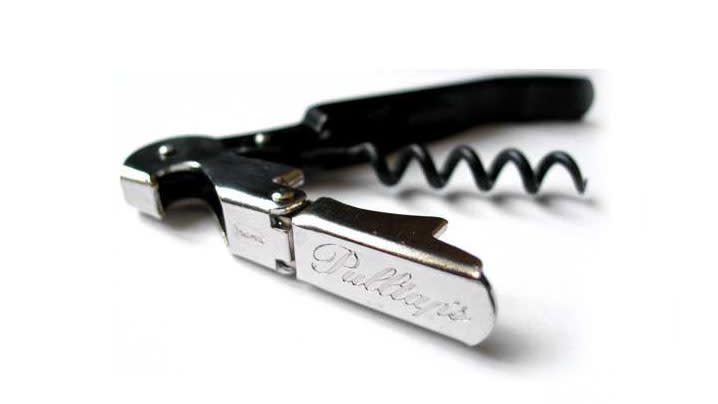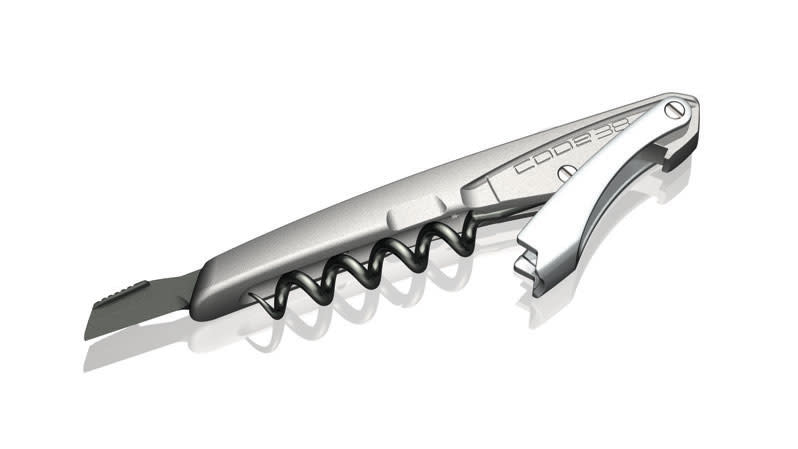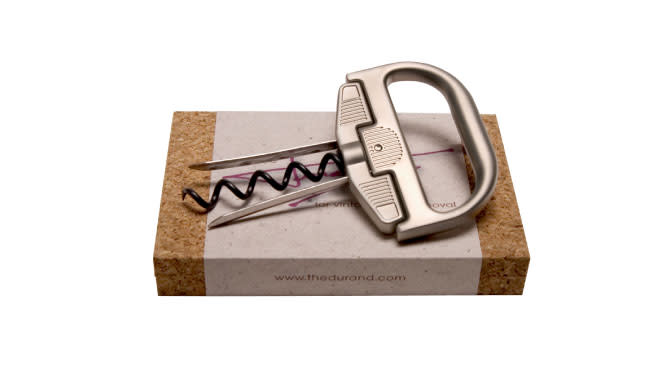The Best Corkscrew
Welcome to F&W Gear Guides, a buyer’s guide to an essential piece of kitchen gear based on real world testing. Missed an installment? Find them all here.
After testing 15 corkscrews over multiple dinner parties, we found the best classic waiter’s friend, a wonderful but extraordinarily costly upgrade, a very nice lever corkscrew, an electric model that beats its competition and a one-of-a-kind opener that’s ideal if you frequently open older bottles.
Our favorite options:
Best Overall Corkscrew: Pulltap’s Double-Hinged Waiter’s Corkscrew (at amazon.com)
An Extremely Pricey Upgrade: Code38 Elite Series 17-4PH (at amazon.com)
Best Lever Corkscrew: Vertical Rabbit (at amazon.com)
Best Electric Corkscrew: Oster Electric Wine Opener (at amazon.com)
Best if You Open a Lot of Older Bottles: The Durand (at amazon.com)
The Search for the Best Corkscrew
As long as wine has been packaged in glass bottles—since the 17th century, roughly—there have been tools designed for the safe removal of cork stoppers. Although they came in many shapes and sizes, most antique corkscrews were variations on the screwpull model. That is, a metal helix (also called a “worm”) sometimes encased in a frame that could be twisted down vertically into a cork, requiring the person wielding it to brace the bottle and tug firmly upwards until the cork emerged, often with a cartoonish popping sound. Screwpulls are still around today. And still effective, too, though I would exercise caution when using one on a bottle of red while wearing a white blouse or dress.
Today, we have better tools for opening bottles. The most ubiquitous model in circulation now is the waiter’s friend, or wine key, which affixes the metal worm to a curved handle in such a way that it can be folded out to a 90-degree angle, à la Swiss Army knife. It’s countered by a fulcrum that rests on the lip of the bottle, providing the resistance needed to pull the cork out through a simple lifting of the handle. Another useful feature is the retractable blade opposite the worm for cutting the wine bottle’s foil capsule. Sommeliers swear by this model for several reasons. One, it’s self-contained. Meaning, no separate foil-cutting device nor any other parts or tools are needed. Two, it’s small enough to fit discreetly in a pocket. And three, it gets the job done swiftly and efficiently.
In a previous job as a tasting coordinator for a prominent wine publication, I would regularly open more than 80 bottles in a single day. A reliable corkscrew was, next to database software, my most essential instrument. And in addition to giving me an impressive Popeye-like forearm muscle, the experience further solidified my appreciation for Pulltap’s Double-Hinged corkscrew—a version of the waiter’s friend that’s durable enough to withstand months of rough repeated use. When it did start to show signs of wear and tear (in the form of a loose hinge or dulled knife blade), it was easily replaceable for just under $10.
Why would anyone use a different corkscrew? Well, 80 bottles a day is way more than most of us open at home, and the pivoting motion involved in using a waiter’s friend model is not 100 percent self-explanatory. For those and other reasons, the market is flooded with alternative models, from levers to automatic devices to specialty cork extractors designed for particularly difficult bottles. To truly test my trusted Pulltap’s worth against other wine bottle openers, I gathered 15 different corkscrews to use over two consecutive dinner parties. I asked for input from friends and family, some in the wine trade, some not. The bottles used were an eclectic mix of reds and whites, some in the Burgundy shape (sloped-shouldered), some in the Bordeaux shape (sharp-shouldered), most with foil capsules, some with wax ones, most with classic corks and some with composite ones, called “Diam.”
What makes a great corkscrew?
As long as the cork comes out of the bottle without a hitch and the wine flows freely, most folks wouldn’t complain about the nuances of corkscrew performance. In the absence of an appropriate tool, there’s always the shoe method (precarious). Or another widely touted hack: using a standard house key (not recommended if you still need to access said house—yes, I’m speaking from personal experience).
But since I was genuinely in search of the best corkscrew, each time I approached a new one I would ask myself a series of questions. Do I easily get the gist of how this device works, simply by looking at it? Is it cumbersome or awkward to wield? Does it have a comfortable grip? Can it successfully execute all steps involved, or are additional parts required? How smoothly does it extract, and does it inflict any noticeable damage to the cork in the process? How long does it take me to open the bottle?
The Best Corkscrews
Best Overall Corkscrew: Pulltap’s Double-Hinged Waiter’s Corkscrew (at amazon.com)

Yes, the waiter’s friend model is still the most efficient at removing corks, with the most compact design. It’s less cumbersome than a lever corkscrew or winged corkscrew and can more easily be stowed away in any kitchen drawer.
Of all of the waiter’s friend models, Pulltap’s Double-Hinged has the best price-quality ratio. Its serrated knife handled any wine bottle foil I threw at it flawlessly. Its Teflon-coated worm twisted smoothly into both classic and Diam corks without any awkward squeaking or bothersome resistance. And its double-hinged fulcrum made it possible to maintain leverage, even with the worm twisted all the way into the cork rather than halfway or most of the way, which is what many single-hinged versions demand.
Pulltap’s technology was conceived in the late ‘90s by an enterprising Spaniard in a town just outside of Barcelona, and that’s still where the corkscrews are manufactured today. Counterfeit versions have been spotted around the U.S., so when purchasing from a third-party retailer, make sure to look for the ‘Made in Spain’ tagline. If you’re not sure whether the corkscrew you already have is a genuine Pulltap’s, see if the worm bends under a little applied pressure. If so, it’s not the real deal.
For an even greater value alternative, look to the Truetap Double-Hinged Waiter’s Corkscrew. It’s almost identical to the Pulltap’s in both appearance and function and is ultra-cheap ($5 on Amazon for a basic white one). In truth, its only flaw is that the knife and fulcrum are slightly looser than those on Pulltap’s, making it less likely to last as long or handle quite as many bottle-openings before needing replacement. If you seldom open more than a bottle per day, it’s likely to last at least a few years.
An Extremely Pricey Upgrade: Code38 Elite Series 17-4PH (at amazon.com)

I had been hearing about how amazing the Code38 is from sommelier friends since the first version came out, a little over 5 years ago. “Why use a cheap-looking wine key that needs to be replaced every few months, when you can have a sleek, aerodynamic one with a lifetime warranty?” they would ask. Did my experience with the current version live up to those high expectations? Absolutely.
The Code38 is basically a corkscrew that was born a waiter’s friend but was educated in the Scandinavian school of design and refurbished with materials that are at once combat-ready and fit for a black tie function. It’s as close to indestructible as possible (you can even opt for a titanium body rather than the standard stainless alloy one), but it’s feather-light when compared to any other fancy waiter’s friend model, such as Laguiole. Rather than a serrated flip-out blade, it has an ergonomic, straight-edged one that allows the user to slide it out one-handed, freeing up the other hand for, well, anything else. The knife function impressed even my mother, who exclaimed, “Oh! I can do it all with one hand!” when I asked her to give it a go. It cut through the foil like a hot knife through butter, without a single jagged nick.
Despite the fulcrum being single-hinged, it had excellent leverage, requiring the least amount of effort of all of the waiter’s models I tried, with any length of cork. But for all its superior qualities, it’s not superior enough over Pulltap’s to get me to shell out between $400 and $600. If money were no object, I’d buy one for every skeptic in my entourage.
Best Lever Corkscrew: Vertical Rabbit (at amazon.com)

The only benefit of the lever model corkscrew over the waiter’s friend is that it cuts the manual worm-twisting out of the cork removal process. Some would also argue that the simplicity of the up-and-down motion of using a lever makes up for its bulky size. Most lever models require separate foil cutters.
Of the three lever models included in my experiment, the Vertical Rabbit felt sturdiest and most durable, with a coated stainless steel body rather than a plastic one. It had a comfortable soft rubber grip and ejected the cork with a firm pop. In addition, when the lever was in its upright position, it stayed upright. The levers in the other models tended to fall unless propped up.
Best Electric Corkscrew: Oster Electric Wine Opener (at amazon.com)

While an electric corkscrew may seem like both a time- and effort-saver, most models require at least 8 hours of charging prior to first use, all require a separate foil-cutting mechanism (included, but not built into the automated cork removal process), and even the best one took almost 10 seconds longer to open a bottle than the Pulltap’s (38.58 vs. 29.31). My companions’ responses to the electric models I tested were comical, which is unsurprising since these devices look and sound more like sex toys than kitchen appliances. Plus, they’re supposed to be stored upright in their charging docks, taking up valuable counter space.
If all that doesn’t sway your opinion, and if you don’t mind having to read instructions like you’re assembling Ikea furniture before opening a bottle of wine… that is, if you’re hell-bent on buying electric, this is the best (though by no means the most attractive) of the three popular brands that I tried. It’s comparatively lightweight and requires pushing a button to set it in motion, which makes it less likely to go off on its own simply by being in contact with another object.
Some human interaction is needed to operate this electric model. I used both hands—one to stabilize the bottle while the corkscrew was engaged (otherwise, the bottle would simply spin around on the counter, and the cork would remain in place) and the other to hold the corkscrew shaft steady and press the button that operates the worm-twisting mechanism. Yet, it removed the cork pretty smoothly without any rips or tears and automatically stopped once the cork had passed the threshold of the bottle’s neck. Meaning, there was no haphazard guessing as to how far out of the bottle it was.
Best if You Open a Lot of Older Bottles: The Durand (at amazon.com)

If you’ve ever encountered a mature bottle with a fragile or diminished cork, you’ll understand why the Durand is a clever invention. Attempts to open such bottles with a waiter’s friend can result in shredding the cork into tiny bits, or at the very least, ripping it in two. For much of corkscrew history, the only other option for opening older bottles was the ah-so—a two-pronged cork extractor that essentially acts like tweezers. You insert the prongs between the cork and the neck of the bottle, wiggling the device back and forth until it’s far enough down to grip the cork, and then carefully twist and pull to remove it intact.
In the case of a diminished cork (one that has shrunken with age), using an ah-so risks pushing it further into the bottle rather than pulling it out. The Durand—a screwpull-plus-ah-so combo—is a fail-safe for exactly that scenario.
To put it to the test, I used a 1990 vintage Cru Bourgeois Médoc, but you could have similar success with a bottle three times as old. The worm twisted smoothly into the cork and held it stable while I worked the prongs down its sides. The whole process was uncomplicated, and the cork came out perfectly and in one piece, with no tearing or remnants remaining in the bottle.
Because of its price tag and its specific design, I wouldn’t recommend the Durand for everyday use, but it’s really the only tool of its kind and can handle even the most difficult and unpredictable of corks.
Also Tested
Waiter’s Corkscrews: Laguiole (at amazon.com) and OXO Steel (at amazon.com)
Laguiole wine keys are still some of the most beautiful sommelier tools on the market. But like a nice pair of Italian leather boots, you wouldn’t want to use one every day, and they take quite a bit of breaking in before they’re comfortable. On the model I used, the knife and worm were both stiff and difficult to fold out from the body, while the single-hinged fulcrum required leaving about a spiral and a half of the worm out of the cork to get the leverage needed to extract it.
The OXO looks almost childish by comparison. Despite its comfortable grip, it has a comically short knife and fulcrum. And while it may work acceptably well on foil-capsule bottles, it is not recommended for use on wax-capsule bottles. It slipped repeatedly on the lip of the bottle I used it on, making a mess of broken wax.
Electric Corkscrews: Wine Enthusiast Electric Blue (at amazon.com) and Rabbit Automatic (at amazon.com)
The Electric Blue corkscrew gets its name from the blue light that emanates from the device when engaged, which I think serves no purpose other than to seem high-tech. It was heavier than the Oster and exhibited some ripping of the cork. Its sole advantage is the transparent plastic lower portion of the shaft, which allows the user to see the cork being removed.
The foil cutter that comes attached to the Rabbit Automatic was so unintuitive that even my sommelier husband couldn’t figure it out. The corkscrew’s automated function and lack of buttons made it foolproof for opening the bottle, but it also made the motor start up when I was simply placing it back in its box, wasting some of its charge.
Lever Corkscrews: Vinturi Vertical (at amazon.com) and Le Creuset Lever (at amazon.com)
The Vinturi lever model corkscrew was the most despised among the dinner guests for its delaying of the party. It took me so long to get the foil off the first bottle, we could have had several bottles open by the time we figured it out.
Le Creuset gave us a much smoother opening experience by comparison, but its plastic body felt flimsy and not built for any degree of wear and tear.
Winged Corkscrew: Williams Sonoma Open Kitchen Winged Corkscrew (at williams-sonoma.com)
Not only are winged corkscrews cumbersome and gangly, they’re also tough on corks, causing ripping. This version was no exception.
Screwpull: Le Creuset Original Table Model Twist Style Corkscrew (amazon.com)
This twist style corkscrew makes sense to throw in a picnic basket: it’s lightweight and compact. But with its plastic frame, it’s way less durable than any waiter’s friend despite taking up slightly more space.
Ah-So: NorPro A2B Cork Puller (amazon.com)
I used this classic ah-so as a basis for judging the performance of the Durand. It’s still a great option for most older bottles, but it won’t work for all of them.

